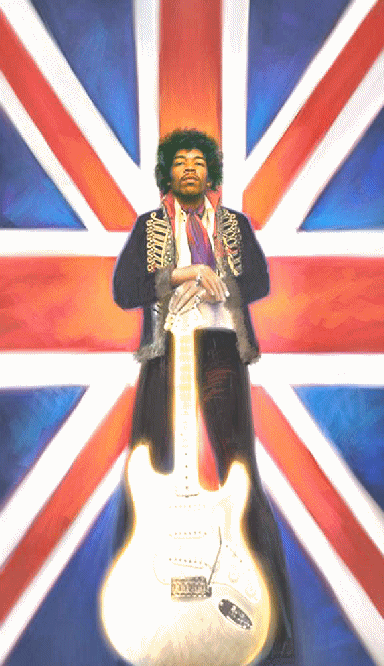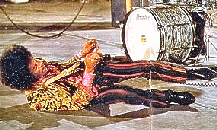In 1964 Hubert and Howlin Wolf joined the first "American Folk Blues Festival" tour of Europe. Big Bill Broonsy had paved the way for such tours in the 1950s. The Broonsy tours demonstrated that a much larger audience for blues existed in Europe than in America. "They knew more about our history than we knew about our own self!" exclaimed Sumlin.
"Everybody was scared to release Red House in America because they said, 'America don't like blues, man!'"
- Jimi
It's often been reported that Hendrix "had to go to England" to become famous before he could return to America as an "imported" act. But isn't that the history of the blues? Muddy Waters described how, "The Rolling Stones came out named after my song, and the next I knew they were out there. And that's how people in the States really got to know who Muddy Waters was." British musicians were the ones who directed mainstream American attention to the blues. "Those English guys," charges Sumlin, "if they tell the truth, they made all their money off of us bluesmen, man. The Beatles, The Rolling Stones, everybody that'd come out of their bag, man."
Jimi & Mick Taylor
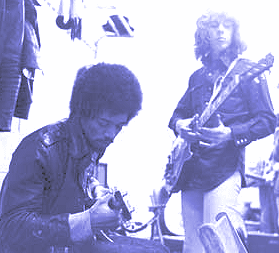
Jimi was to retrace this transatlantic cycle at the behest of Chas Chandler, the producer who'd come to America as a member of the "British Blues" Animals. "You have to remember," Chas said, "that this artist had been on stage with a lot of very influential blues players in America. Doing the chitlin' circuit in America, that's got to rub off on you, I mean if you don't entertain on them shows they throw things at you, so you've got to learn to entertain damn quick. And it all just came to fruition with two little lads from England."
"It was really interesting the way it came down," revealed Mike Nesmith of The Monkees, "because I had hooked up with Clapton, George Harrison, Lennon and McCartney for dinner...And Lennon had at the time a little transistor cassette player, and he said, 'you gotta hear this thing', and he played Hey Joe. Everybody sat around sort of reverentially listening to this Hey Joe. Of course it was so stunning to hear this particular record, because it completely and utterly altered the way we all thought about music. And to see these guys standing there with their jaws dropped was even more impressive."
Jimi & Eric Clapton
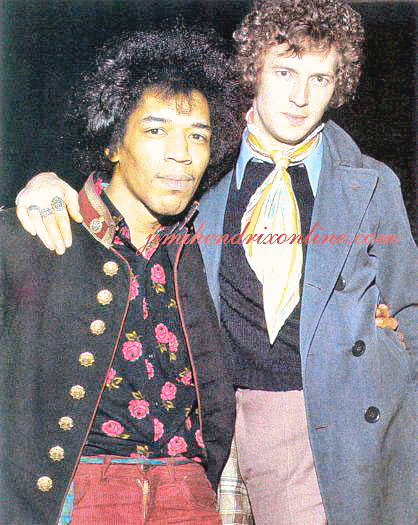
"The stage was set for Jimi," explained Clapton. "London was just coming into a kind of really heavy soul thing. The blues boom was dying and it needed someone to bring it all back to life and sort of cement it together." Clapton assessed Jimi's roots, "We sort of dug up all our heros and compared them and we actually thought the same. He liked Robert Johnson, he liked Freddie and B.B. King, and he liked Buddy Guy. He liked all the same people and he just seemed to be conversant in all this. I mean it was such a thrill for me because it was all second hand, in reality, for me, it was something that I learned from records. This guy had been amongst them and was one of them...I was a one-way player. I played strict Chicago blues, I never tried to cross it with anything. And he had this melting pot going on that he'd drawn from different places."
"Jimi Hendrix held his own with anybody," noted B.B. King. "To me, he was one of the great explorers of the so called Delta blues. I don't think it has anything to do with where a person is born. A lot of people play blues who have never been to the South or even have been to the United States. He was Jimi Hendrix, he didn't sound like anybody else but himself. He was like Charlie Parker in his way of playing, he was a person that made waves."
"Jimi was launched like some combination of King Kong and B.B. King," said Chas.
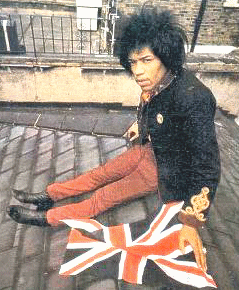
In London Jimi combined his blues with British rock. A fellow Seattle-native, Ray Charles, had made similar waves a decade earlier. Big Bill Broonzy once railed against Charles' unprecedented mixture of gospel with blues. Now Jimi added jazzz drums and rock bass. "If I'd had two bluesmen with me," he warned, "we'd have gone straight into one bag, the blues. That's not for me. We might do our own arrangement of a Howlin' Wolf number followed straight away by Wild Thing or a Bob Dylan number. This way we can do anything and develop our own music. We'll do things our own way and make our own sound. I knew where I was at when it came to specialist blues scenes, 'specially from my experience back in the States. I was completely unknown in America until the word got back that the British dug my kind of music. Now it's 'sell-out' business there." With the phenomenal appeal of the Experience, Jimi became the first blues artist to cross-over to the mass white audience. He crossed over two years before B.B. King did.
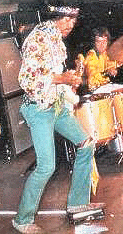
"B.B. King had a hit single in '69," recalls Dick Waterman, "and although he was older and had made hundreds more records for the black market, Albert King was on the white scene first." Albert King's breakthrough Born Under A Bad Sign sessions were recorded in '66 at a time when teens were just starting to realize that great black musicians were behind recent hits by the Stones and the Yardbirds. Albert's crossover occurred in February 1968 when he was booked to open a string of Hendrix concerts in San Francisco. Those gigs catapulted the Big Bluesman into the realm of '60s rock. It was a fitting reunion for Albert and Jimi.
"The first time I saw him after he left Tennessee was in San Francisco," Albert recalled. "I hadn't seen him in about five years, and he had this hot record out. So I went back in the dressing room and we laughed and talked and hugged one another. I was glad to see him. I think I shook him up a little bit because he didn't expect me to be that close to him, playing-wise. Everybody said, 'He's a hell of a blues player.' Now wait a minute! That night I taught him a lesson about the blues, playing your blues where they can understand it, instead of floor-showing. He had a row of buttons (sound effects) on the floor, and a big pile of amplifiers stacked on one another. And he'd punch a button with his foot and get something else.
Then when he'd get through playing he'd take his guitar and ram it through his amplifier (laughs). Now, that record he put out,
Foxy Lady, that wasn't blues, but it was big. But when you want to really come down and play the blues, well, I could've very easily played his songs, but he couldn't play mine."
Jimi's "floor-showing" was well within the tradition of early Delta blues. "Charley Patton was a clowning man with a guitar," said his half-brother Sam Chatmon. "He'd be in there putting his guitar all between his legs, carry it behind his head, lay down on the floor, and never stopped picking."







